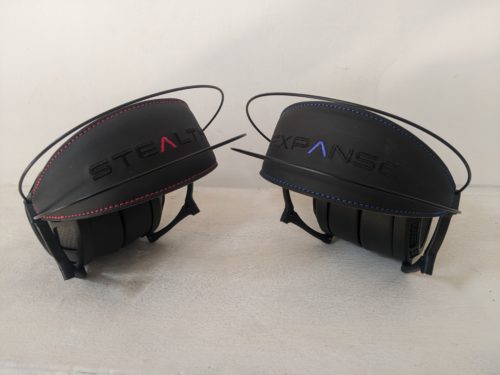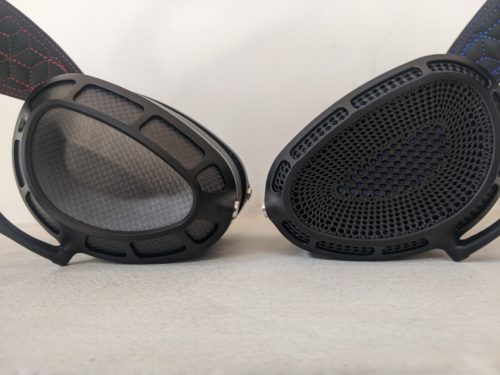Dan Clark Audio: Stealth vs. Expanse Comparison Review
Dan Clark Audio released Stealth, their most recent flagship closed-back, over-ear headphone, back in the summer of 2021. About a year since then, the company has now released its new open-back flagship: Dan Clark Audio Expanse. The Stealth and Expanse are based on very similar technology and design principles, but still have their own significantly distinct qualities that are worthy of consideration by anyone deciding between the two; that is, if you’re one of the lucky ones who can afford the $3,999 price that both are tagged with. Without further ado, let’s see what these two pairs of premium audiophile over-ears have to offer.

Look, Feel, and Design
The Expanse and Stealth are basically siblings. They come with the same accessories and have the same materials going into their particularly flexible build. Both are equipped with with a leather self-adjusting suspended headband connected to a highly malleable headband structure made of aluminum and nickel. Hinged carbon fiber gimbles give the cans 180 degrees of swivel and allows them to fold into the headband, providing durable portability. Both have the same high quality earcup padding made of leather and suede, firm carrying case, and 4 pin outputs.
Both feature similar extra high quality engineering and technological features: 76mm x 51mm 4th generation planar magnetic drivers, AMTS (Acoustic Metamaterial Tuning System) that squashes distortion along with the FEA and CFD optimized motors. Also featured in both headphones is their improved driver tensioning systems for enhanced stability across the frequency spectrum and extra distortion attenuation.
Differences start to emerge when we look at the weight of the Expanse and Stealth, which are 418 grams and 415 grams respectively. They are decently lightweight in the context of audiophile headphones, and I can promise you that both distribute their weight exceedingly well so that those 3 grams will not be a noticeable when they’re on your head.
Also, perhaps obviously, the open-back cans on the Expanse are different from the closed-back design of the Stealth. While the Stealth cans are made from a solid carbon-aluminum bonding with a grid like design printed onto them, the Expanse opts for the same material but in the form of an open, hexagonal grill pattern for their open-back design. Needless to say, the Stealth has more isolation than its open back counterpart. That being said, I find the Stealth to be a bit light on isolation in context with other closed-backs, while the the Expanse has a bit more isolation than most open-backs.

Sound Stage
I’ll get into the specifics in a moment, but quite plainly, the sound stage winner is clearly the Expanse with its open-back advantage. You don’t have to overthink its name in order to realize that Dan Clark Audio was aware of this characteristic when they engineered the headphone. In a previous review, I made special note of its tall, tent-shaped sound image that creates intense spatial layering. While the Stealth still creates a decently 3D image, it’s strength lies more in a linear, left-right plane. Don’t get me wrong: the Stealth’s imaging is still whip-lash fast and retains a wondrous, dizzying quality. But the Expanse takes that same energy and stretches it out, sending it flying back at you from every direction. While the width of the two images are comparable, the Expanse outdoes the Stealth in its length, and especially in its height.
To my surprise, their balances are more different than I expected. The Expanse has a noticeably neutral EQ balance that treats the frequency spectrum pretty evenhandedly. Lows rumble when called upon to do so but don’t quite drive the mix, while the mids and highs expose fine details without overstaying their welcome. The Stealth on the other hand leans further into its low end and high mids, staying neutral in the center mids before lightly attenuating the highs. To put it simply, the Expanse prioritizes accuracy where the Stealth prioritizes a rich character.
Lows
Round one might have gone to the Expanse for its sound stage, but the lows are where the Stealth has its comeback. The Expanse’s subs can be a notch quieter than some listeners might be used to; while they’re capable of ramping up, I’m left with a feeling of lower frequency waves passing by my ear rather than penetrating it. The Stealth’s lows are tastefully boosted and aggressive, and treat some of its low mids to a boost as well. Electric basses had more of a warm growl, and kick drums delivered more of a physical sensation that made them feel like they were situated in the center of my cranium. While the Expanse’s still-respectable lows have a certain lightweight quality (much like the rest of its sonic balance), the Stealth opts for solid pillars of impactful low end.
Mids
The middle of the frequency spectrum is where the Stealth and the Expanse start seeing eye-to-eye again, at least for a little while. Generally speaking, both headphones go for balanced mids with realistic harmonic expression. Both have a pretty great distinction between their lows and low mids that avoids muddiness and keeps things precise. While the Expanse stays balanced pretty much through and through, the Stealth starts creeping back up in volume in its high mids. This isn’t an unfamiliar timbre for high end closed-backs: boosting low end and then balancing it out with a boost somewhere higher up the frequency spectrum. The Stealth’s high mid boost is most obvious in the extra crack that it packs in snares and scratchiness in hi-hats. Coupled with its low end, the Stealth is ideally primed for a boom-bap sound, while the Expanse stands by neutrally and honestly with it’s more stable balance.
Highs
Thanks in part to their shared planar drivers and AMTS component, both headphones treat their highs with respect and avoid unwanted shrill resonances. That being said, the Stealth is a fair bit quieter in the highs than the Expanse, relying on its high mids to supply brightness. The Expanse, on the other, seems to fly up the frequency spectrum in a fairly straight line, undisturbed by significant boost or attenuation. Each headphone seems to follow its own sonic philosophy that gets uniquely expressed in how it handles its high frequencies: the Stealth is concerned with a moderately shaped sound and is likely trying to avoid becoming too noisy by not having the very top of the frequency spectrum compete alongside it’s boosted high-mid slap, while the Stealth seeks to prioritize natural balance that includes the shimmery frequencies above 10 kHz. The two headphones diverge significantly in their treatment of highest frequencies, but each has its own good reasons for doing what they do.

Overall
The Stealth and Expanse have enough in common, from their pristine mids to their exceptional layering that gives each part of a mix lots of room to be itself. And let’s not forget that they both share a hefty but well-justified $3,999 price tag. The differences between the two, however, really shouldn’t be understated. On one side, we have the Stealth, with its punchy low end and rich sound character playing to its advantage. On the other, we have the Expanse, with its accurate balance and huge imaging making it a worthy competitor. As for me? I like the Expanse a bit more, as the imaging really did have me thinking about it hours after I had to sadly put it back away in its box. But I’m also not the biggest bass head, and generally enjoy flat and analytical headphones which is a preference conducive to the Expanse’s well-balanced timbre. The choice between the two is very much a subjective decision, as I can honestly say that both The Stealth and Expanse are worthy of being a top-shelf trophy in any audiophile’s headphone collection; they’re simply made for different types of listeners.
Dan Clark Audio Expanse and Stealth are available at Audio46.
MAJORHIFI may receive commissions from retail offers.








